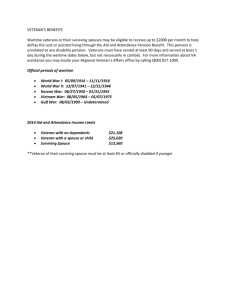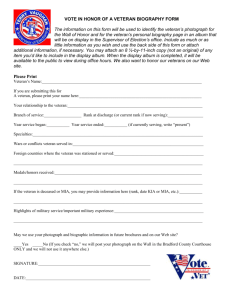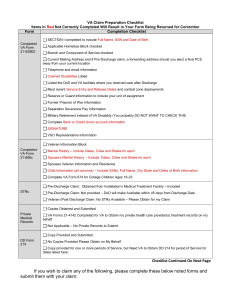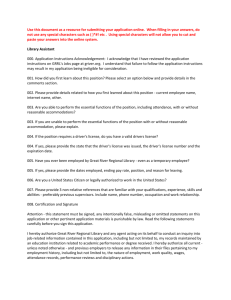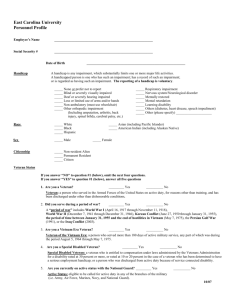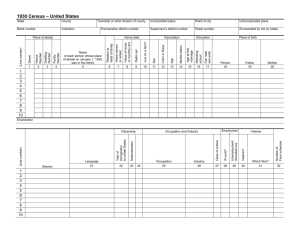Citation Nr: 0413922 - Blue Water Navy Vietnam Veterans Association
advertisement
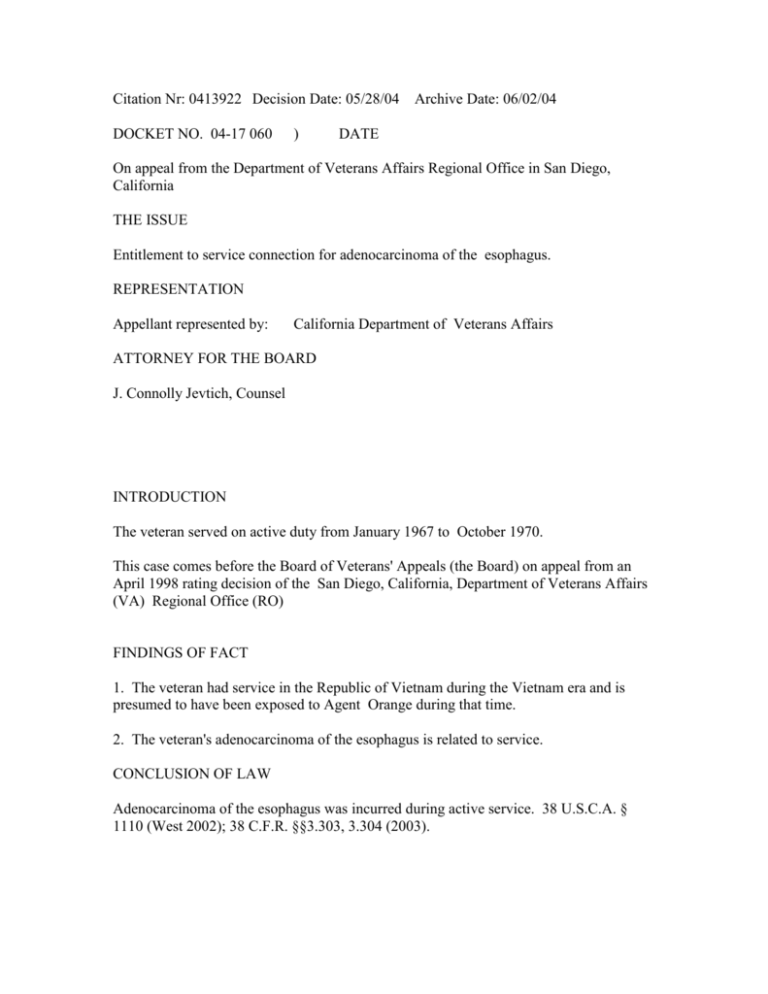
Citation Nr: 0413922 Decision Date: 05/28/04 DOCKET NO. 04-17 060 ) Archive Date: 06/02/04 DATE On appeal from the Department of Veterans Affairs Regional Office in San Diego, California THE ISSUE Entitlement to service connection for adenocarcinoma of the esophagus. REPRESENTATION Appellant represented by: California Department of Veterans Affairs ATTORNEY FOR THE BOARD J. Connolly Jevtich, Counsel INTRODUCTION The veteran served on active duty from January 1967 to October 1970. This case comes before the Board of Veterans' Appeals (the Board) on appeal from an April 1998 rating decision of the San Diego, California, Department of Veterans Affairs (VA) Regional Office (RO) FINDINGS OF FACT 1. The veteran had service in the Republic of Vietnam during the Vietnam era and is presumed to have been exposed to Agent Orange during that time. 2. The veteran's adenocarcinoma of the esophagus is related to service. CONCLUSION OF LAW Adenocarcinoma of the esophagus was incurred during active service. 38 U.S.C.A. § 1110 (West 2002); 38 C.F.R. §§3.303, 3.304 (2003). REASONS AND BASES FOR FINDINGS AND CONCLUSION There has been a significant change in the law during the pendency of this appeal with the enactment of the Veterans Claims Assistance Act (VCAA). 38 U.S.C.A. § 5100, 5102, 5103, 5103A, 5106, 5107, 5126 (West 2002). To implement the provisions of the law, the VA promulgated regulations at 38 C.F.R. §§ 3.102, 3.156(a), 3.159, 3.326(a)). The amendments became effective November 9, 2000, except for the amendment to 38 C.F.R. § 3.156(b) which became effective August 29, 2001. Except for the amendment to 38 C.F.R. § 3.156(a), the second sentence of 38 C.F.R. § 3.159(c), and 38 C.F.R. § 3.159(c)(4)(iii), VA stated that "the provisions of this rule merely implement the VCAA and do not provide any rights other than those provided in the VCAA." 66 Fed. Reg. 45,629. Accordingly, in general where the record demonstrates that the statutory mandates have been satisfied, the regulatory provisions likewise are satisfied. The Act and implementing regulations eliminate the concept of a well-grounded claim, redefine the obligations of VA with respect to the duty to assist, and supersede the decision of the United States Court of Appeals for Veterans Claims in Morton v. West, 12 Vet. App. 477 (1999), withdrawn sub nom. Morton v. Gober, 14 Vet. App. 174 (per curiam order) (holding that VA cannot assist in the development of a claim that is not well grounded). First, VA has a duty to notify the veteran and his representative, if represented, of any information and evidence needed to substantiate and complete a claim. 38 U.S.C.A. §§ 5102, 5103. Second, VA has a duty to assist the veteran in obtaining evidence necessary to substantiate the claim. 38 U.S.C.A. § 5103A. The Board is, at this time, granting the veteran's claim; thus any deficiencies in this case as to VCAA are harmless and nonprejudicial. Service connection may be granted for disability resulting from disease or injury incurred in or aggravated by service. 38 U.S.C.A. § 1110. For the showing of chronic disease in service there is required a combination of manifestations sufficient to identify the disease entity and sufficient observation to establish chronicity at the time, as distinguished from merely isolated findings or a diagnosis including the word "chronic." Continuity of symptomatology is required where the condition noted during service is not, in fact, shown to be chronic or where the diagnosis of chronicity may be legitimately questioned. When the fact of chronicity in service is not adequately supported, then a showing of continuity after discharge is required to support the claim. 38 C.F.R. § 3.303(b) (2003). A chronic, tropical, or prisoner-of-war related disease, or a disease associated with exposure to certain herbicide agents, listed in 38 C.F.R. § 3.309 will be considered to have been incurred in service under the circumstances outlined in this section even though there is no evidence of such disease during the period of service. No condition other than the ones listed in 38 C.F.R. § 3.309(a) will be considered chronic. 38 U.S.C.A. §§ 1101, 1112, 1113, 1116; 38 C.F.R. § 3.307(a). A veteran who, during active military, naval, or air service, served in the Republic of Vietnam during the period beginning on January 9, 1962, and ending on May 7, 1975 shall be presumed to have been exposed during such service to an herbicide agent, unless there is affirmative evidence to establish that the veteran was not exposed to any such agent during that service. The last date on which such a veteran shall be presumed to have been exposed to an herbicide agent shall be the last date on which he or she served in the Republic of Vietnam during the period beginning on January 9, 1962, and ending on May 7, 1975. "v Service in the Republic of Vietnam" includes service in the waters offshore and service in other locations if the conditions of service involved duty or visitation in the Republic of Vietnam. 38 U.S.C.A. § 1116(f); 38 C.F.R. §3.307(a)(6)(iii). If a veteran was exposed to an herbicide agent during active military, naval, or air service, the following diseases shall be service-connected if the requirements of 38 U.S.C.A. §1116, 38 C.F.R. § 3.307(a)(6)(iii) are met, even though there is no record of such disease during service, provided further that the rebuttable presumption provisions of 38 U.S.C.A. § 1113; 38 C.F.R. § 3.307(d) are also satisfied: chloracne or other acneform diseases consistent with chloracne, Hodgkin's disease, multiple myeloma, nonHodgkin's lymphoma, acute and subacute peripheral neuropathy, porphyria cutanea tarda, prostate cancer, respiratory cancers (cancer of the lung, bronchus, larynx, or trachea), soft-tissue sarcomas (other than osteosarcoma, chondrosarcoma, Kaposi's sarcoma, or mesothelioma), diabetes, and chronic lymphocytic leukemia. 38 C.F.R. § 3.309(e). Further, VA regulation provides that with chronic disease shown as such in service (or within the presumptive period under 38 C.F.R. § 3.307) so as to permit a finding of service connection, subsequent manifestations of the same chronic disease at any later date, however remote, are service connected, unless clearly attributable to intercurrent causes. For the showing of chronic disease in service there is required a combination of manifestations sufficient to identify the disease entity, and sufficient observation to establish chronicity at the time, as distinguished from merely isolated findings or a diagnosis including the word "chronic." When the disease identity is established (leprosy, tuberculosis, multiple sclerosis, etc.), there is no requirement of evidentiary showing of continuity. Continuity of symptomatology is required only where the condition noted during service (or in the presumptive period) is not, in fact, shown to be chronic or where the diagnosis of chronicity may be legitimately questioned. When the fact of chronicity in service is not adequately supported, then a showing of continuity after discharge is required to support the claim. 38 C.F.R. 3.303(b). Service connection may be granted for any disease diagnosed after service when all the evidence establishes that the disease was incurred in service. 38 C.F.R. § 3.303(d); Combee v. Brown, 34 F.3d 1039, 1042 (Fed. Cir. 1994). A claim for service connection requires competent evidence of a current disability; proof as to incurrence or aggravation of a disease or injury in service, as provided by either lay or medical evidence, as the situation dictates; and competent evidence as to a nexus between the in-service injury or disease and the current disability. Cohen v. Brown, 10 Vet. App. 128, 137 (1997); Layno v. Brown, 6 Vet. App. 465 (1994). The United States Court of Appeals for the Federal Circuit has determined that a claimant is not precluded from establishing service connection with proof of direct causation. Combee; Ramey v. Brown, 9 Vet. App. 40, 44 (1996), aff'd sub nom. Ramey v. Gober, 120 F.3d 1239 (Fed. Cir. 1997), cert. denied, 118 S.Ct. 1171 (1998). See also Brock v. Brown, 10 Vet. App. 155, 160-61 (1997). The veteran served on active duty from January 1967 to October 1970. His service record confirms service in Vietnam. Thus, exposure to Agent Orange is presumed. It is further noted that the veteran served in combat and is entitled to consideration of 38 U.S.C.A. § 1154(b). The veteran was initially diagnosed as having esophageal cancer in October 2002. The veteran maintains that his esophageal cancer is a result of exposure to Agent Orange during his service in Vietnam. Esophageal cancer/adenocarcinoma of the esophagus is not one diseases listed at 38 C.F.R. § 3.309(e). Thus, the Board will consider if direct service connection is warranted. In support of his claim, the veteran has submitted two letters from his private treating physician, J. W., who is a diplomate in internal medicine, medical oncology, and hematology, as well as a March 2004 letter of another private treating physician, Dr. D. B., another of his treating physicians who is an oncologist specialist. In the first letter of Dr. J. W., dated in January 2003. Dr. J. W. stated that the veteran had been under his care for esophageal cancer since November 2002. He indicated that the veteran had no known risk factors for the development of his neoplasm beyond his exposure to Agent Orange during service. In support of his opinion, Dr. J. W. submitted medical literature which addressed the health effects of dioxin exposure in a 20-year mortality study. In reviewing this literature, the physician found that there was an increased relative risk of "other digestive cancers." Although the study did not list these other types of cancers, he concluded that the study factored out stomach, cancer, colon, rectum, hepabillary, liver, and pancreatic cancer. The Board notes that in viewing the study, these types of cancers were listed under the heading of "digestive cancers" and were listed individually. Also listed under "digestive cancers" was a category entitled "other digestive." Dr. J. W. opined that this other category, after factoring out the enumerated cancers, left only esophageal and small bowel neoplasms unaccounted for; thus, they were the cancers in the catchall category. Dr. J. W. stated that he had not been able to find a specific reference to adenocarcinoma of the esophagus and Agent Orange due to the relatively rare occurrence of this cancer as compared to breast, lung, colon, and rectal cancers. However, with the referenced medical literature and the lack of a specific study, it was his opinion that there was an association between esophageal cancer and Agent Orange. He stated that it was his belief that Agent Orange was at least a factor or possibly the cause of the veteran's esophageal cancer. In his second letter, dated in March 2003, Dr. J. W. expanded on his earlier letter and addressed the veteran's documented history of cigarette smoking and any etiological relationship to his development of esophageal cancer. Dr. J. W. stated that there was a strong association with tobacco use and alcohol use and the development of squamous cell cancer of the esophagus, however, not with adenocarcinoma, which is the type of cancer from which the veteran suffers. Dr. J. W. stated that in patients with Barrett's esophagus, there might be an increased risk with tobacco, but the veteran did not have a preexisting history of Barrett's esophagus. In sum, the physician indicates that as the veteran did not have a preexisting history of Barrett's esophagus, since most cases do not have smoking as a risk factor, and because of the Agent Orange components have been shown to increase adenocarcinoma of the digestive tract, the physician felt that it was likely that the veteran's exposure to Agent Orange was a risk factor or causative factor in his esophageal cancer. In April 2003, the veteran was afforded a VA examination. The examiner reviewed the veteran's history and took note of his past exposure to Agent Orange as well as tobacco use. The examiner indicated that he had read literature with regard to Agent Orange exposure. The examiner also indicated that carcinoma of the esophagus, adeno or squamous, was not listed as one of the Agent Orange diseases. However, the examiner stated that in reviewing the article referenced by Dr. J. W., there was discussion about the rate possibility of cancers of the esophagus. Usually cancers of the esophagus are squamous cell carcinoma and related to smoking and alcohol use, rarely is the carcinoma adenocarcinoma of the esophagus, which is often related to Barrett's esophagitis which is due to reflux. The examiner noted that the veteran did not seem to have reflux. The examiner indicated that the article did say that gastrointestinal cancers are rare and esophagus cancer is very rare. The examiner stated that the Agent Orange protocol says that carcinoma of the esophagus is not an accepted diagnosis from Agent Orange, it seemed as likely as not that this carcinoma of the esophagus could be related to Agent Orange. In July 2003, the veteran's case was referred to the Under Secretary for Health. The Chief Public Health and Environment Hazards Officer provided a statement. She noted that the veteran had served in Vietnam in 1969 and 1970. She stated that he subsequently was diagnosed with adenocarcinoma of the esophagus arising in the milieu of Barrett's esophagus in 2002. She related that the most recent general Institute of Medicine (IOM) national Academy of Sciences report of herbicides used in Vietnam did not specifically address the question of possible association between exposure to herbicides and specifically esophageal cancer. She stated that this indicated that the information obtained from their extensive review of all available scientific and medical literature, to include the medical literature cited above, did not permit the IOM to assign this disorder to one of its specific categories. Moreover, the IOM committee reviewed the article cited by Dr. J. W., and apparently esophageal carcinoma is not included with "other digestive" cancers in that paper's analysis. The VA physician indicated that a lot of weight was being given to the IOM findings on the health effects from exposure to herbicides in Vietnam. Therefore, at this time, she could not say that it was likely or at least as likely as not that esophageal cancer was the result of exposure to herbicides used in Vietnam. In March 2004, Dr. D. B., stated that prior to his diagnosis of adenocarcinoma of the esophagus, the veteran did not have a history of gastrointestinal problems including regurgitation, heartburn, nausea, vomiting, or early satiety. Dr. D. B. noted that the veteran had a history of exposure to Agent Orange. He stated that the veteran had very little of the typical symptoms associated with the development of adenocarcinoma of the esophagus such as reflux symptoms, indigestion, and only presented with late symptoms of dysphasia. The physician opined that it seemed reasonable that his esophageal adenocarcinoma related to his past Agent Orange exposure. The physician explained that while the veteran had a history of tobacco use, this exposure was a significant risk factor for squamous cell carcinoma of the esophagus, not adenocarcinoma of the esophagus; thus, it was unlikely that his social habits had any relation to the development of adenocarcinoma of the esophagus. Dr. D. B. concluded that the veteran had known Agent Orange exposure. Agent Orange exposure was related to adenocarcinoma of the digestive tract. The veteran had none of the usual/typical risk factors of adenocarcinoma of the esophagus. He stated that it was reasonable to conclude that his Agent Orange exposure greatly increased his risk of developing adenocarcinoma of the esophagus. The Board disagrees with the AOJ's assessment in this case. While the AOJ states that the doctors did not adequately discuss or evaluate the veteran's other risk factors in developing his cancer, the Board finds that this is not the case. The private oncologists and the VA examiner who examined the veteran did in fact consider the veteran's risk factors and discussed them in each report. It was noted by all three physicians that the veteran had a history of smoking, but since he had adenocarcinoma and not squamous cell carcinoma, this was not felt to be an etiological factor. In addition, Barrett's esophagus was specifically ruled out. Thus, the veteran's various risk factors were adequately explored. The United States Court of Appeals for the Federal Circuit Court has stated that service connection can be granted on a direct basis, not just a presumptive basis. As such, other diseases, besides those deemed by VA to be presumptive diseases may be serviceconnected. In order for them to be service-connected, there must be competent evidence establishing a nexus to service. The fact that a condition is not a presumptive disease is not relevant. In this case, Dr. J. W. made such an assessment and opined that the medical literature that he submitted did support his conclusion. Dr. J. W. discussed his supporting medical literature. In reviewing this literature, the physician found that there was an increased relative risk of "other digestive cancers." He addressed the fact that the study did not specifically list adenocarcinoma of the esophagus. However, he concluded that since the study factored out stomach, cancer, colon, rectum, hepabillary, liver, and pancreatic cancer, the "other digestive" category included esophageal and small bowel neoplasms. Dr. J. W. is an expert in oncology. He is competent to make that assessment. His opinion is confirmed by Dr. D. B. and the VA examiner. The VA examiner addressed the fact that the article did say that gastrointestinal cancers are rare and esophagus cancer is very rare. Likewise, Dr. J. W. stated that the veteran's type of cancer was rare as compared to breast, lung, colon, and rectal cancers. Dr. D. B., who did not appear to rely on the referenced study, opined that the veteran had none of the usual/typical risk factors of adenocarcinoma of the esophagus. In essence, he indicated that the veteran's sole risk factor was his Agent Orange exposure. Thus, the Board does not agree with the AOJ with regard to those arguments. The Board finds that the three supporting medical opinions are competent and supported by medical literature. The two private physicians are the veteran's treating oncologists and are specialists in their field of medicine. In addition, the VA examiner also had an opportunity to examine the veteran. They are all in agreement that the veteran's Agent Orange exposure played a role in his development of adenocarcinoma of the esophagus. They have supported their opinions, as noted above. However, a question remains as to whether those positive opinions are outweighed by the negative opinion of the Chief Public Health and Environment Hazards Officer. In reviewing this opinion, the Board notes that the Chief Public Health and Environment Hazards Officer's opinion is also competent. However, in this particular case, her opinion is outweighed. First of all, she stated that the veteran had been diagnosed with adenocarcinoma of the esophagus arising in the milieu of Barrett's esophagus in 2002. The veteran's adenocarcinoma of the esophagus has not been found to have any relationship to Barrett's esophagus and has been deemed by the treating oncologists to be without similar symptoms. The treating oncologists discussed such in detail. The veteran has not had the typical symptoms, his symptoms are not those of Barrett's esophagus or having similarity to such. Second, she stated that the most recent IOM report did not specifically address the question of possible association between exposure to herbicides and specifically esophageal cancer. She indicated that the reason was that their extensive review of all available scientific and medical literature, to include the cited medical literature, did not permit the IOM to assign this disorder to one of its specific categories. The Board has recognized that esophageal cancer is not in fact a presumptive disorder. However, the treating oncologists and the VA examiner have indicated that the veteran's specific type of cancer is so rare that there are insufficient studies. This is not discounted by the Chief Public Health and Environment Hazards Officer. As noted, she stated that the most recent IOM report did not specifically address the question of possible association between exposure to herbicides and specifically esophageal cancer. However, it was her opinion that such an omission amounted to that disease having been ruled out as being associated by the IOM committee as being associated with dioxin exposure. The three other physicians raise the possibility that the omission does not amount to an exclusion, but rather is based on the rare occurrences of this type of cancer and lack of studies in that regard. It was pointed out that while it is not among the recognized types of cancers, the veteran's cancer is very unusual and atypical. The three other physicians felt that in this particular case, the fact that there was not a specific study on esophageal cancer was not determinative. It did not mean that there was no relationship between adenocarcinoma and Agent Orange exposure. In sum, the Chief Public Health and Environment Hazards Officer stated that she could not say that it was likely or at least as likely as not that esophageal cancer was the result of exposure to herbicides used in Vietnam. However, the Board finds it significant to note that she was requested to state whether it was likely, as likely as not, or unlikely, that the veteran's esophageal cancer was related to Agent Orange. While, she indicated that she could not say that it was likely or at least as likely as not that esophageal cancer was the result of exposure to herbicides used in Vietnam, she did not state that it was unlikely or rule out that possibility. She basically indicated that it was not currently recognized by IOM and that prevented her from stating that it was likely or at least as likely as not that esophageal cancer was the result of exposure to herbicides used in Vietnam. Conversely, the three other physicians opined that it was as likely as not that the veteran's esophageal cancer was the result of exposure to herbicides used in Vietnam. The Board finds that the three positive opinions outweigh the negative opinion. The three positive opinions are based on expert knowledge in oncology, personal knowledge of the veteran's history, examination and treatment of the veteran, and supporting medical literature as reviewed and explained in the medical reports. They discuss the unusual and rare nature of the veteran's cancer. They rule out the other possible risk factors for this cancer. They correctly note that the veteran had Agent Orange exposure. They conclude that Agent Orange exposure is an etiological factor. The negative opinion appears to rest entirely on the fact that esophageal cancer has not been determined to be a presumptive disorder by the IOM. None of the veteran's specific symptoms, unusual circumstances of his cancer, or accurate factors were discussed. Nothing specific to the veteran's case was referenced except for the fact that he served in Vietnam and that he had esophageal cancer. The only other specific reference was an analogy to Barrett's esophagus, which the veteran has not had. In light of the foregoing, the Board accords less probative weight to this opinion. The evidence supports the claim of service connection for adenocarcinoma of the esophagus. Accordingly, service connection is warranted for adenocarcinoma of the esophagus. ORDER Service connection is granted for adenocarcinoma of the esophagus. ____________________________________________ H. N. SCHWARTZ Veterans Law Judge, Board of Veterans' Appeals Department of Veterans Affairs
